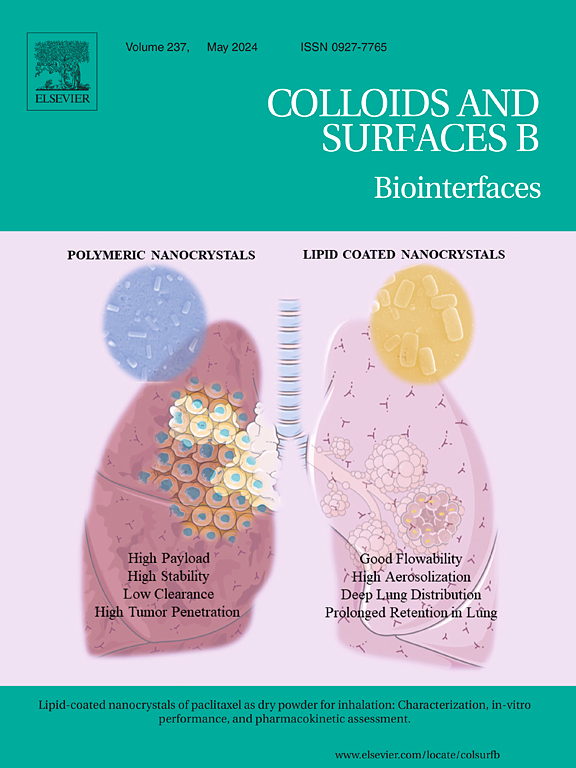PCA-assisted direct diagnosis of Aβ proteins for Alzheimer's disease using non-metallic SERS platform of graphitic carbon nitride@metal-organic framework
IF 5.4
2区 医学
Q1 BIOPHYSICS
引用次数: 0
Abstract
Here, we explored a non-metallic surface enhanced Raman scattering (SERS) platform based on graphitic carbon nitride@metal-organic framework (g-C3N4@MOF) for the sensitive direct diagnosis of Aβ proteins, assisted by principal component analysis (PCA). By systematically optimizing the deposition voltage and time, we successfully achieved a uniform coating of g-C3N4 nanosheets over a large-area copper foil during the initial electrodeposition step. Subsequently, a homogeneous layer of flower-like MOF structures was deposited onto the g-C3N4 nanosheets through a secondary electrodeposition process. This cooperation of g-C3N4 nanosheets and flower-like MOF not only significantly enlarged the effective area for molecular enrichment but also promoted charge transfer through energy-level matching between the two materials. The characteristic SERS spectra of Aβ40 and Aβ42, enhanced by the g-C3N4@MOF composite substrate, were recorded and classified using PCA to extract informative features of these important biomarkers. This research exploits a new avenue for the clinical assay of neurodegenerative diseases by extracting informative features of key biomarkers.
利用石墨碳nitride@metal-organic框架的非金属SERS平台,pca辅助阿尔茨海默病Aβ蛋白的直接诊断
在此,我们探索了一种基于石墨碳nitride@metal-organic框架(g-C3N4@MOF)的非金属表面增强拉曼散射(SERS)平台,用于在主成分分析(PCA)的辅助下对a β蛋白进行敏感的直接诊断。通过系统地优化沉积电压和时间,我们成功地在初始电沉积步骤中在大面积铜箔上均匀地涂覆了g-C3N4纳米片。随后,通过二次电沉积工艺在g-C3N4纳米片上沉积了一层均匀的花状MOF结构。g-C3N4纳米片与花状MOF的合作不仅显著扩大了分子富集的有效面积,而且通过两种材料之间的能级匹配促进了电荷转移。通过g-C3N4@MOF复合底物增强a - β40和a - β42的特征SERS光谱,用PCA进行分类,提取这些重要生物标志物的信息特征。本研究通过提取关键生物标志物的信息特征,为神经退行性疾病的临床检测开辟了一条新的途径。
本文章由计算机程序翻译,如有差异,请以英文原文为准。
求助全文
约1分钟内获得全文
求助全文
来源期刊

Colloids and Surfaces B: Biointerfaces
生物-材料科学:生物材料
CiteScore
11.10
自引率
3.40%
发文量
730
审稿时长
42 days
期刊介绍:
Colloids and Surfaces B: Biointerfaces is an international journal devoted to fundamental and applied research on colloid and interfacial phenomena in relation to systems of biological origin, having particular relevance to the medical, pharmaceutical, biotechnological, food and cosmetic fields.
Submissions that: (1) deal solely with biological phenomena and do not describe the physico-chemical or colloid-chemical background and/or mechanism of the phenomena, and (2) deal solely with colloid/interfacial phenomena and do not have appropriate biological content or relevance, are outside the scope of the journal and will not be considered for publication.
The journal publishes regular research papers, reviews, short communications and invited perspective articles, called BioInterface Perspectives. The BioInterface Perspective provide researchers the opportunity to review their own work, as well as provide insight into the work of others that inspired and influenced the author. Regular articles should have a maximum total length of 6,000 words. In addition, a (combined) maximum of 8 normal-sized figures and/or tables is allowed (so for instance 3 tables and 5 figures). For multiple-panel figures each set of two panels equates to one figure. Short communications should not exceed half of the above. It is required to give on the article cover page a short statistical summary of the article listing the total number of words and tables/figures.
 求助内容:
求助内容: 应助结果提醒方式:
应助结果提醒方式:


